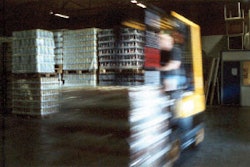"The-Package-Is-The-Tag" offering features adaptive EPC Gen 2 family of tags for item-level RFID
Cambridge, MA — February 28, 2006 — Radio frequency identification specialist TAGSYS has released a new offering dubbed "The-Package-Is-The-Tag," a solution combining ultra-small, low-cost RFID tags and an adaptive antenna built into a product's packaging.
The-Package-Is-The-Tag Program incorporates UHF "Kernel" tags and an antenna that is customized to, and intrinsically incorporated within, the packaging of the item to be RFID-enabled. Taken together, these parts match RFID performance to individual product needs, TAGSYS said.
This new approach to item-level RFID enables the integration of radio frequency technology into packaging strategies so that RFID becomes a component of the package. The approach is designed to increase the ability to authenticate and safeguard goods, enable real time inventory and item visibility, and automate labor intensive processes in industries such as packaged goods, fashion and apparel, and courier or luggage tracking, according to TAGSYS.
In its first embodiment, the new, patented Adaptive Kernel family of tags (AK) forms the basis for the new approach. The AK family of tags incorporates an EPC Gen 2 universal module and a custom-designed antenna to meet specific client requirements. The world's smallest Gen 2 tag, the AK module measures just 12mm x 8mm. TAGSYS has both granted and pending patents on the module.
According to TAGSYS, the antenna allows the tag to become an integral part of the packaging. The tag is customizable to customers' packaging shapes, materials and sizes, nature of goods in the packaging, industrial environment, processes organization, reading distances and conditions, privacy requirements and region of use.
The result is a flexible tag approach where the chip module is common across all applications. This provides economies of scale and lowered costs while allowing customers to deploy tags to meet their specific needs by using an antenna that is delivered in different form factors and using materials such as conductive ink, aluminum or copper, according to the solution provider.
"The-Package-is-the-Tag approach and the AK family of tags herald a new step forward for item-level RFID," said Elie Simon, CEO of TAGSYS. "With EPCglobal's ratification of Gen 2 standards, the industry is now able to leverage the innovation and advancements around UHF-based technologies for item-level applications. Through this new adaptable and flexible solution for item-level RFID, we believe that we will be able to offer our clients a completely customized, cost-efficient, reliable, accurate and secure RFID offering and will help drive the delivery of item-level RFID in new sectors."
Based on a TAGSYS methodology to assist customers in evaluating, designing and deploying an end-to-end item-level RFID infrastructure, the approach has been tested on items such as courier envelopes and boxes, luggage tags, item boxes of various shapes and sizes, and fashion price tags.
Unit prices for the TAGSYS AK family of tags as inlays can be as low as 5 to 8 cents, according to the solution provider. The tags are currently available to select clients and partners for testing and deployment and will be available for large-volume orders during the second half of 2006. Testing kits are also available on request.
TAGSYS said it currently is collaborating with DOW CORNING to develop printed antennas and fully integrated material system solutions for RFID industries and packaging manufacturers.
"The-Package-is-the-Tag approach is an extraordinary step forward in the implementation of RFID in manufacturing and packaging," said Marie Eckstein, general manager of advanced technologies and ventures at DOW CORNING Corporation. "With this new approach, TAGSYS is bringing to market an entirely new level of flexibility for deploying RFID."
Additional Articles of Interest
— RFID technology has the potential to change the way supply chains are managed, but in order to be effective businesses need to take a holistic look at the deployment. Read more in the SDCExec.com article "Time for RFID: Applying RFID in the Supply Chain."
— For a contrary view of the future of the RFID market, see the article "The O'RFID Factor: A 'No Spin' Look at Where Radio Frequency Identification Is Headed," in the October/November 2004 issue of Supply & Demand Chain Executive.
- More articles about TAGSYS.











